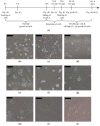Microfluidic Platform for the Long-Term On-Chip Cultivation of Mammalian Cells for Lab-On-A-Chip Applications
- PMID: 28698531
- PMCID: PMC5539486
- DOI: 10.3390/s17071603
Microfluidic Platform for the Long-Term On-Chip Cultivation of Mammalian Cells for Lab-On-A-Chip Applications
Abstract
Lab-on-a-Chip (LoC) applications for the long-term analysis of mammalian cells are still very rare due to the lack of convenient cell cultivation devices. The difficulties are the integration of suitable supply structures, the need of expensive equipment like an incubator and sophisticated pumps as well as the choice of material. The presented device is made out of hard, but non-cytotoxic materials (silicon and glass) and contains two vertical arranged membranes out of hydrogel. The porous membranes are used to separate the culture chamber from two supply channels for gases and nutrients. The cells are fed continuously by diffusion through the membranes without the need of an incubator and low requirements on the supply of medium to the assembly. The diffusion of oxygen is modelled in order to find the optimal dimensions of the chamber. The chip is connected via 3D-printed holders to the macroscopic world. The holders are coated with Parlyene C to ensure that only biocompatible materials are in contact with the culture medium. The experiments with MDCK-cells show the successful seeding inside the chip, culturing and passaging. Consequently, the presented platform is a step towards Lab-on-a-Chip applications that require long-term cultivation of mammalian cells.
Keywords: Lab-on-a-Chip; MDCK; cell cultivation; diffusion model; hydrogel; parylene.
Conflict of interest statement
The authors declare no conflict of interest. The founding sponsors had no role in the design of the study; in the collection, analyses, or interpretation of data; in the writing of the manuscript, and in the decision to publish the results.
Figures








Similar articles
-
PDMS-free microfluidic cell culture with integrated gas supply through a porous membrane of anodized aluminum oxide.Biomed Microdevices. 2018 Nov 10;20(4):98. doi: 10.1007/s10544-018-0343-z. Biomed Microdevices. 2018. PMID: 30413897
-
An All-Glass Microfluidic Network with Integrated Amorphous Silicon Photosensors for on-Chip Monitoring of Enzymatic Biochemical Assay.Biosensors (Basel). 2017 Dec 5;7(4):58. doi: 10.3390/bios7040058. Biosensors (Basel). 2017. PMID: 29206205 Free PMC article.
-
Rapid spheroid clearing on a microfluidic chip.Lab Chip. 2017 Dec 19;18(1):153-161. doi: 10.1039/c7lc01114h. Lab Chip. 2017. PMID: 29192297
-
A review of digital microfluidics as portable platforms for lab-on a-chip applications.Lab Chip. 2016 Jul 7;16(13):2376-96. doi: 10.1039/c6lc00387g. Epub 2016 Jun 8. Lab Chip. 2016. PMID: 27272540 Review.
-
Recent advances in microfluidic devices for single-cell cultivation: methods and applications.Lab Chip. 2022 Apr 12;22(8):1438-1468. doi: 10.1039/d1lc01030a. Lab Chip. 2022. PMID: 35274649 Review.
Cited by
-
Applications of Polymers for Organ-on-Chip Technology in Urology.Polymers (Basel). 2022 Apr 20;14(9):1668. doi: 10.3390/polym14091668. Polymers (Basel). 2022. PMID: 35566836 Free PMC article. Review.
-
Application of Polymethylpentene, an Oxygen Permeable Thermoplastic, for Long-Term on-a-Chip Cell Culture and Organ-on-a-Chip Devices.Micromachines (Basel). 2023 Feb 24;14(3):532. doi: 10.3390/mi14030532. Micromachines (Basel). 2023. PMID: 36984939 Free PMC article.
-
Aging on Chip: Harnessing the Potential of Microfluidic Technologies in Aging and Rejuvenation Research.Adv Healthc Mater. 2025 Aug;14(20):e2500217. doi: 10.1002/adhm.202500217. Epub 2025 Jun 12. Adv Healthc Mater. 2025. PMID: 40509615 Free PMC article. Review.
-
Gas transport mechanisms through gas-permeable membranes in microfluidics: A perspective.Biomicrofluidics. 2023 Nov 16;17(6):061301. doi: 10.1063/5.0169555. eCollection 2023 Dec. Biomicrofluidics. 2023. PMID: 38025658 Free PMC article.
-
In vitro biocompatibility evaluation of a heat-resistant 3D printing material for use in customized cell culture devices.Eng Life Sci. 2022 Mar 31;22(11):699-708. doi: 10.1002/elsc.202100104. eCollection 2022 Nov. Eng Life Sci. 2022. PMID: 36348657 Free PMC article.
References
-
- Schurink B., Luttge R. Hydrogel/poly-dimethylsiloxane hybrid bioreactor facilitating 3D cell culturing. J. Vac. Sci. Technol. B Nanotechnol. Microelectron. Mater. Process. Meas. Phenom. 2013;31:06F903. doi: 10.1116/1.4831762. - DOI
-
- Yu T., Guo Z., Fan H., Song J., Liu Y., Gao Z., Wang Q. Cancer-associated fibroblasts promote non-small cell lung cancer cell invasion by upregulation of glucose-regulated protein 78 (GRP78) expression in an integrated bionic microfluidic device. Oncotarget. 2016;7:25593. doi: 10.18632/oncotarget.8232. - DOI - PMC - PubMed
MeSH terms
Substances
LinkOut - more resources
Full Text Sources
Other Literature Sources
Miscellaneous

